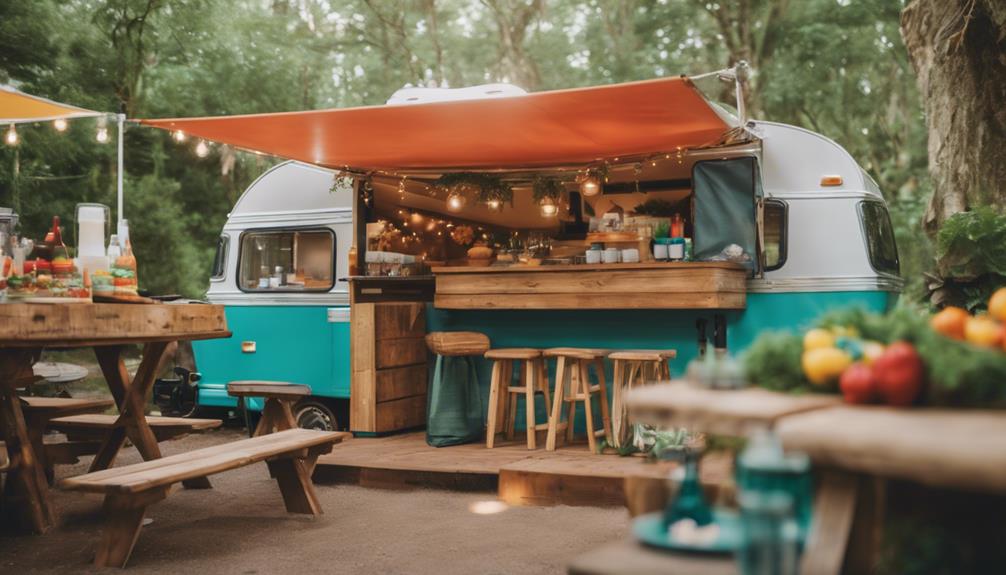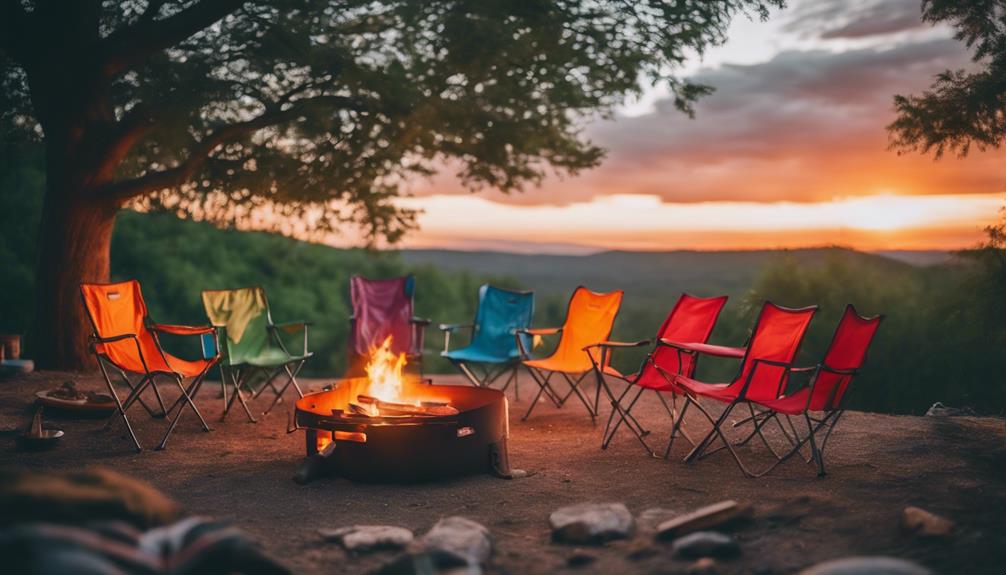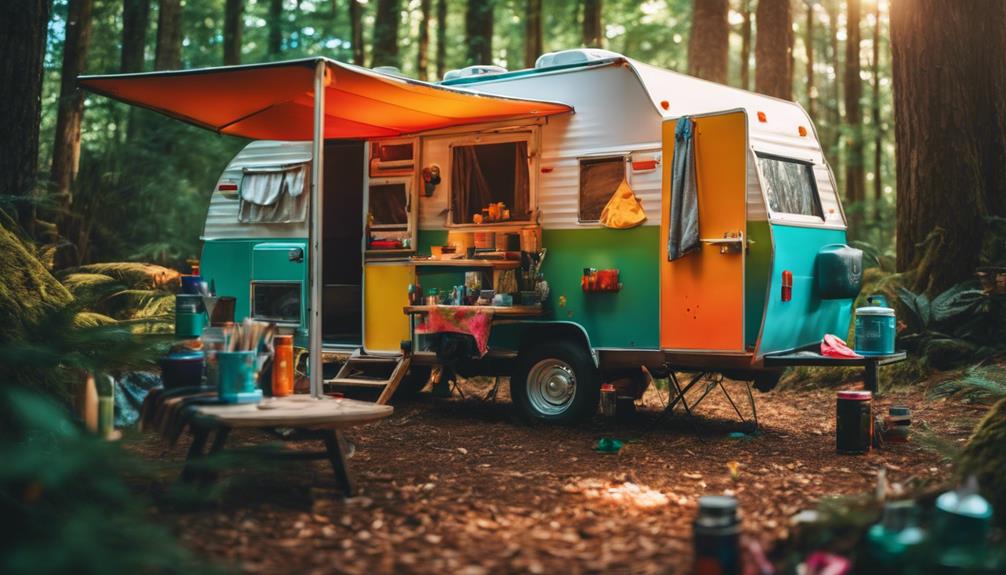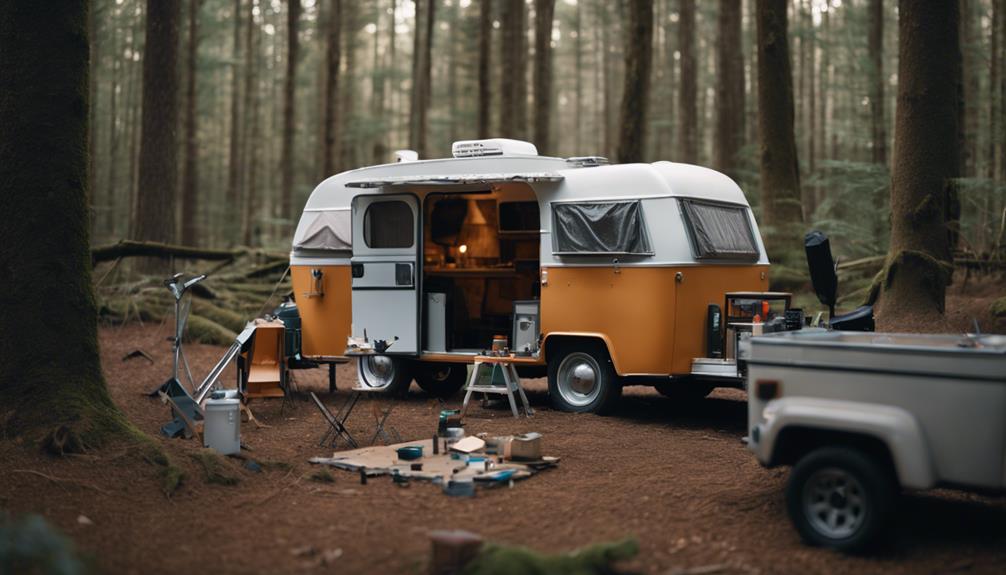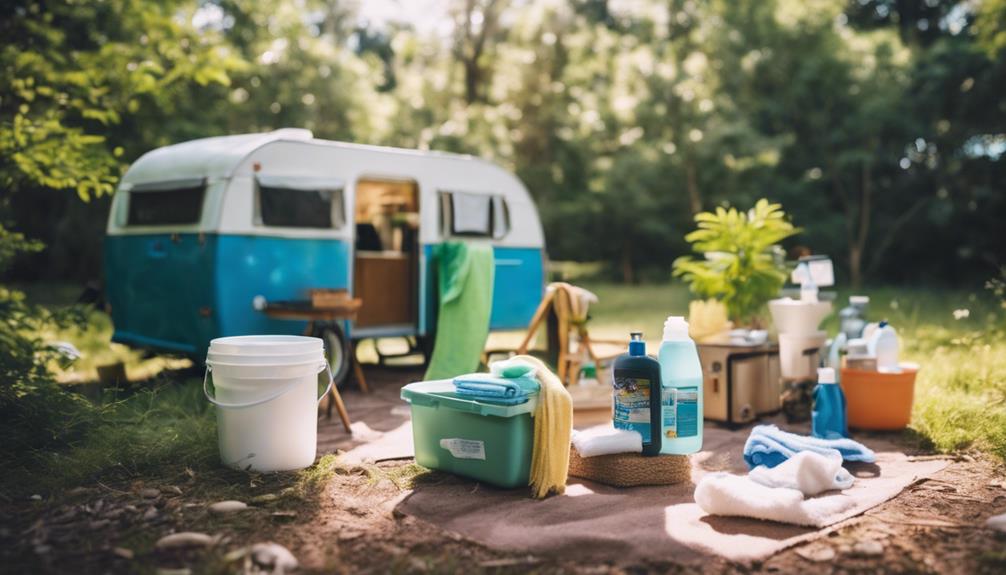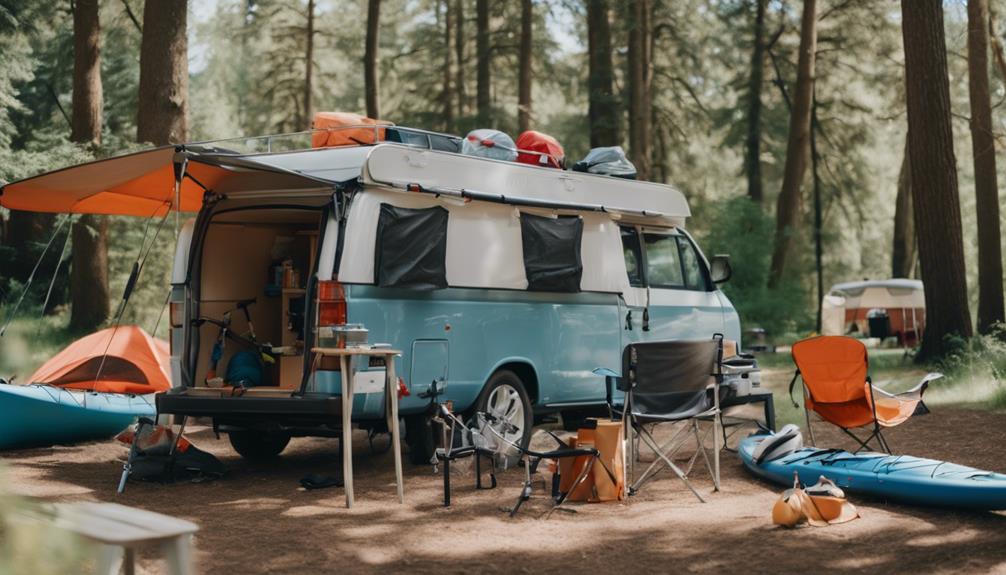Converting a pop-up camper into a food trailer requires careful assessment and modifications. Start by checking the camper's condition, ensuring its framework supports the weight of kitchen equipment. Next, install essential cooking gear, like grills and refrigeration units, while creating a multifunctional layout for efficient food prep. Don't forget to install proper sanitation systems and comply with local health regulations for safe operations. Finally, consider your branding and marketing strategy to attract customers. If you're ready to get started, you'll discover more tips and tricks to streamline your conversion process.
Key Takeaways
- Assess the camper's overall condition, focusing on framework stability, electrical, plumbing systems, and compliance with local health regulations.
- Install essential cooking equipment, including grills and refrigeration, while ensuring proper ventilation and fire suppression systems for safety.
- Optimize space with multifunctional layouts, vertical storage solutions, and compact appliances to enhance workflow and efficiency.
- Budget carefully, starting with a used camper and allocating funds for materials and essential equipment, keeping total expenses under $6,000.
Assessing Your Pop-Up Camper
Start by evaluating your pop-up camper's overall condition, focusing on the framework, canvas, and any existing electrical or plumbing systems.
Check for any signs of wear or damage that could require repairs or upgrades. A solid framework is vital for safely supporting kitchen equipment, so make certain it can handle the extra weight.
Next, assess the interior layout. You want to create an efficient workflow for food preparation and service.
Consider where you'll place cooking appliances, storage, and serving areas to maximize the available space.
Don't forget to investigate local health and safety regulations regarding food trailers.
You'll need to verify your camper complies with sanitation, ventilation, and food storage requirements.
This compliance is fundamental for operating legally and keeping customers safe.
Essential Modifications for Cooking
When converting your pop-up camper into a food trailer, you'll need to think carefully about your cooking equipment requirements.
Optimizing your space is essential, so you can efficiently prepare and serve your menu items.
Let's explore how to set up your kitchen for success.
Cooking Equipment Requirements
To successfully convert a pop-up camper into a food trailer, you'll need to carefully select and install essential cooking equipment like grills, fryers, and ovens that match your menu. Here are three key components you'll need to take into account:
- Water System: A complete water system, including sinks and tanks, is vital for food safety and hygiene. Make sure you have enough capacity to meet health department regulations.
- Commercial Hood System: Installing a commercial hood system is often required by state regulations. This guarantees proper ventilation and compliance with safety standards, keeping your cooking area safe and comfortable.
- Fire Suppression Systems: Don't overlook fire suppression systems—they're frequently mandated for food trailers. This additional safety measure is important for protecting your equipment and staff.
While investing in professional-grade cooking equipment can be costly, think about budget-friendly DIY options. For instance, building steam tables and counters using non-porous materials can greatly reduce conversion costs while maintaining functionality.
Space Optimization Techniques
Optimizing space in your pop-up camper is fundamental for creating an efficient food trailer, allowing you to maximize functionality without feeling cramped.
Start by designing a multifunctional layout that integrates a prep area, cooking equipment, and storage solutions. This approach guarantees every inch counts, making your cooking experience smoother.
Incorporate vertical storage options, like shelves and hanging racks, to keep your essential cooking utensils organized and within arm's reach. This tactic frees up precious counter space, enabling you to work more comfortably.
Consider implementing foldable or collapsible furniture, such as tables and chairs, that you can tuck away when not in use. This creates a more spacious working environment, which is essential in a limited area.
When selecting cooking equipment, opt for compact cooking appliances that serve multiple purposes, like a combination oven or stovetop. These tools minimize your footprint while maintaining functionality.
Finally, guarantee proper ventilation by installing an exhaust fan or vent hood. This step is critical for air quality and safety, making your food trailer a pleasant space to cook in.
Compliance With Health Regulations
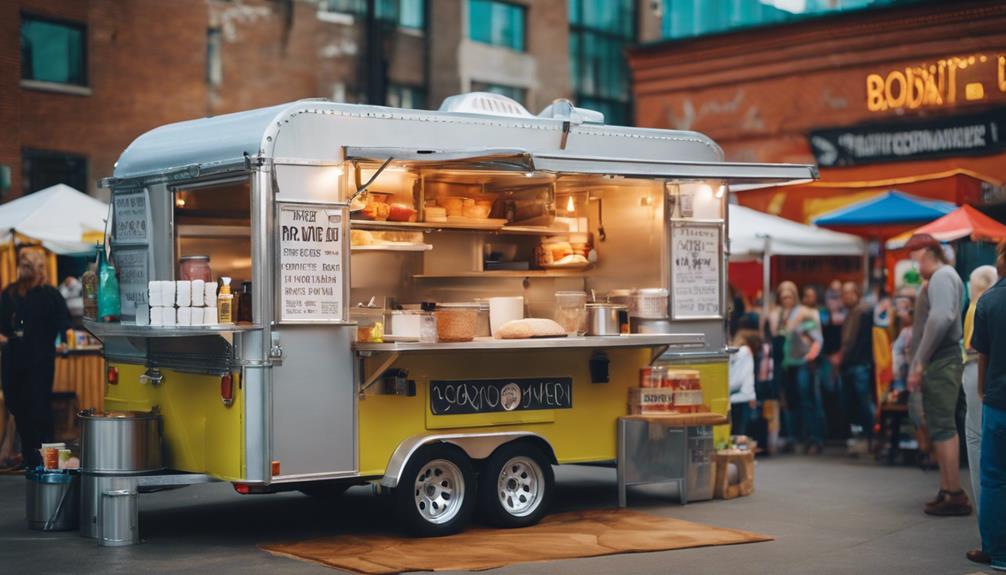
When converting your pop-up camper into a food trailer, you need to prioritize compliance with local health standards.
This means securing the necessary permits, adhering to sanitation requirements, and preparing for regular inspections.
Staying informed about these regulations is essential for running a safe and successful food business.
Local Health Standards
Researching and adhering to local health standards is essential for guaranteeing your pop-up camper food trailer meets all necessary regulations and permits. You'll need to navigate various requirements to operate legally and safely.
Here are three key areas to focus on:
- Food Service Licenses: Obtain the appropriate licenses specific to your region. This often involves submitting applications and paying fees, so check with your local health department for details.
- Hygiene Standards: Verify your camper's interior is built with non-porous materials to maintain hygiene. This is critical for passing inspections and keeping your food safe.
- Health Codes Compliance: Install a complete water system that includes handwashing and food prep stations, as many local health codes mandate this. Additionally, check if you need fire suppression systems for your cooking equipment.
Regular inspections by local health departments will be part of your journey, so maintaining cleanliness and following food safety practices is essential for ongoing compliance.
Sanitation Requirements
Meeting sanitation requirements is vital for guaranteeing your pop-up camper food trailer operates within health regulations and keeps your customers safe. To start, you'll need to use non-porous materials for your interior walls. This choice not only promotes hygiene but also makes cleaning easier.
A complete water system is essential; installing both a fresh water tank and a waste water tank will help you meet sanitation requirements effectively.
Don't forget about handwashing facilities! You must have sinks equipped with hot and cold running water, as this is a key aspect of health department standards. Regularly monitoring and maintaining these facilities will keep your operations compliant.
Additionally, proper ventilation systems, like exhaust fans, are necessary for maintaining air quality in your food trailer, as mandated by health regulations.
Following local health codes, including proper food storage and temperature controls, is equally important. By adhering to these sanitation requirements, you'll not only guarantee compliance but also provide a safe dining experience for your customers, building trust and a solid reputation for your food trailer business.
Permits and Inspections
To successfully convert your pop-up camper into a food trailer, you must navigate the maze of permits and inspections required by local health regulations. These regulations can vary greatly depending on where you plan to operate, so thorough research is imperative.
Here's what you need to focus on:
- Health Permits: Obtain the necessary health permits specific to your local jurisdiction. These are essential for legal operation and compliance with health regulations.
- Inspections: Be prepared for inspections that will evaluate your food trailer's setup, including food storage, preparation areas, and sanitation practices. Confirm everything meets health standards.
- Equipment Compliance: Verify that all your equipment, from cooking appliances to plumbing systems, adheres to health and safety standards. Proper refrigeration and waste management are critical.
Staying updated on local zoning laws is also important, as they dictate where you can park and operate your food trailer.
Regularly review any changes to health regulations since maintaining compliance is key to your business's longevity.
Taking these steps helps guarantee your food trailer's success while keeping your customers safe.
Equipping Your Food Trailer
Equipping your food trailer requires careful planning and consideration of essential equipment to guarantee efficiency and compliance with health regulations.
Start by installing a complete water system that includes sinks and tanks to meet hygiene standards. You'll need adequate counter space for food preparation, so consider using durable materials or even recycled materials for a budget-friendly solution.
Next, invest in a reliable refrigeration unit to assure food safety, as keeping ingredients fresh is critical. Don't forget about power; a dependable generator is necessary to supply energy for cooking appliances tailored to your menu, like grills and fryers.
Additionally, make certain your setup complies with local health and safety regulations. This may involve installing commercial hood systems and fire suppression systems for your cooking equipment.
If you're handy, think about DIY options for components like steam tables and counters, which can enhance functionality and reduce costs.
Branding and Exterior Design
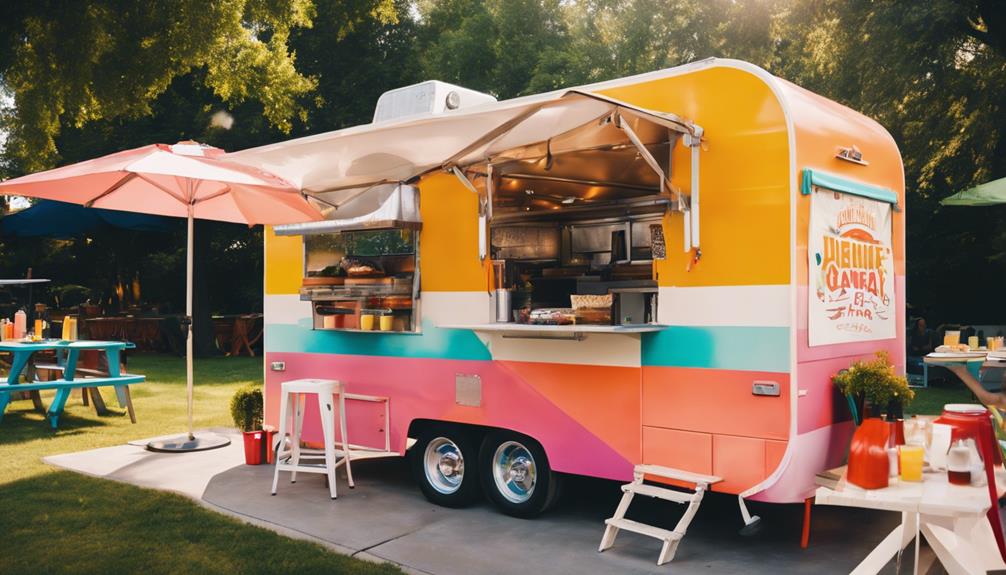
An eye-catching exterior design can make your pop-up camper food trailer stand out and draw in customers at busy events and festivals. To create a memorable brand presence, consider these three key elements:
- Vibrant Colors and Themed Graphics: Use colors and designs that reflect your menu. This helps establish a cohesive brand identity that resonates with your target audience.
- Clear Signage: Confirm your food truck's name and menu items are displayed prominently in easy-to-read fonts. This allows potential customers to quickly identify what you offer, enhancing their experience and increasing sales.
- Inviting Atmosphere: Add outdoor lighting and decorative elements to the exterior. An inviting look can draw in customers, especially during evening events.
Remember to research local regulations regarding food truck signage to confirm compliance while maximizing your brand's visibility.
Utilities and Point of Sale
Creating a successful food trailer goes beyond just branding; it also hinges on establishing reliable utilities and an efficient point of sale system.
First, you need a dependable power supply. Investing in a generator that meets the energy demands of your cooking appliances, refrigeration, and lighting is essential for smooth operation during service hours.
Water systems are another significant aspect of your food trailer's utilities. You'll need fresh and wastewater tanks, along with sinks for food preparation and handwashing. These features are crucial for maintaining hygiene and ensuring compliance with health regulations. Consider installing an on-demand LP gas water heater for instant hot water, enhancing your ability to clean and cook effectively.
On the technology side, a user-friendly Point of Sale (POS) system is essential. It should accommodate various payment methods, track sales, and manage inventory. This not only streamlines your operations but also helps you provide a better customer experience.
Budgeting for Your Conversion
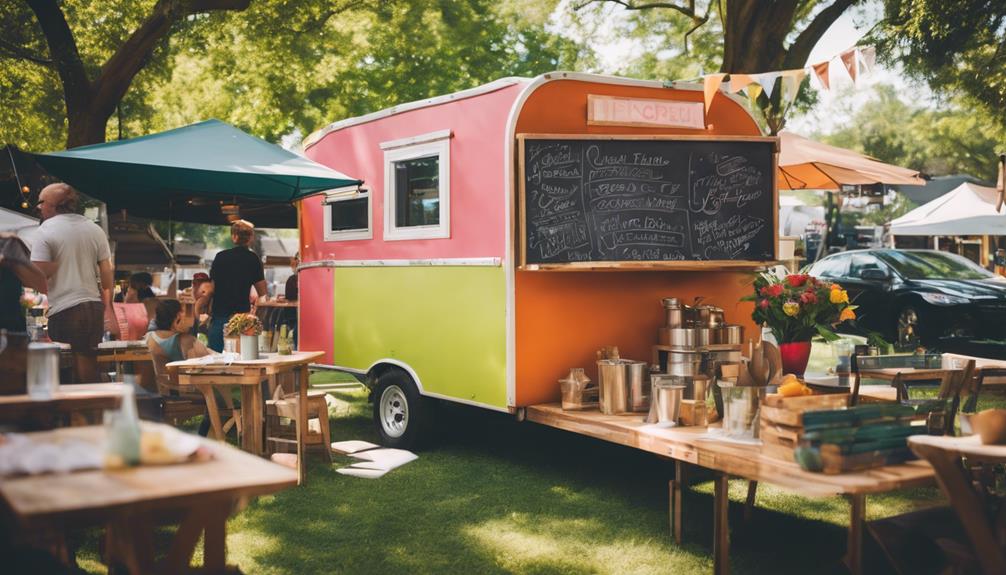
Budgeting for your pop-up camper conversion into a food trailer requires careful planning to keep costs under $6,000. To achieve this, you'll want to break down your expenses into clear categories.
Camper Purchase: Start with a used pop-up camper, which can be found for as low as $300. This initial investment allows you to allocate more funds toward essential equipment and materials.
Materials: Allocate around $400 for materials, including wood, metal, and fabric. These will help enhance both the aesthetics and functionality of your food trailer.
Equipment: Budget for equipment like grills, fryers, and refrigeration units. A well-equipped setup can cost around $2,000, so prioritize your needs to stay within budget.
Don't forget to factor in compliance costs for local health and safety regulations; these can add unexpected expenses if not accounted for initially.
Marketing Your Mobile Cuisine
Once you've set your budget and acquired your pop-up camper, it's time to focus on marketing your mobile cuisine to attract customers and generate buzz.
Start by creating a visually appealing brand identity. A distinctive logo and eye-catching design for your food trailer will draw attention, especially at community events and busy areas.
Leverage social media platforms to promote your food trailer. Share tantalizing photos of your menu items and announce your upcoming locations. Engaging with potential customers online helps build anticipation and loyalty.
Participating in local community events and festivals is key to increasing visibility. These events allow you to interact directly with customers, establish a loyal base, and showcase your unique offerings. Consider offering seasonal menus that cater to local tastes. This not only enhances the appeal of your mobile cuisine but also encourages repeat visits.
Lastly, build partnerships with local businesses and organizations. Cross-promoting services can help you gain access to prime vending locations and expand your reach. By implementing these marketing strategies, you'll create a buzz around your food trailer and attract a steady stream of customers.
Frequently Asked Questions
Can You Turn a Van Into a Food Truck?
Yes, you can turn a van into a food truck! You'll need to make certain it meets health regulations, install necessary equipment, and plan the layout efficiently to maximize space and workflow for your food service.
How to Build a Food Trailer Step by Step?
To build a food trailer step by step, start by budgeting, designing your layout, constructing necessary components, installing utilities, and ensuring compliance with health regulations. Don't forget to secure permits for operation!
Is a Pop up Camper the Same as a Travel Trailer?
No, a pop-up camper isn't the same as a travel trailer. You'll notice pop-up campers are lightweight and collapsible, while travel trailers are larger, more rigid, offering more space and amenities for your adventures.
What Is a Folding Pop up Camper?
Imagine a cozy, lightweight home on wheels. A folding pop-up camper's collapsible design gives you an easy-to-tow retreat, featuring a canvas tent, basic kitchen, and comfortable seating for family adventures in nature's embrace.
Can the Same Pop-Up Camper Conversion for a Food Trailer Also Be Used for a Fish House?
Yes, it is possible to convert popup camper into fish house. The same pop-up camper conversion for a food trailer can be used for a fish house with some modifications to accommodate the specific needs of a fish house. This can be a cost-effective and efficient way to repurpose a camper for multiple uses.
Conclusion
Converting your pop-up camper into a food trailer can open up exciting opportunities in the culinary world.
Did you know that the food truck industry is projected to reach $1 billion by 2024?
With the right modifications and a solid business plan, you can tap into this growing market.
So, take the plunge, get creative, and turn your camper into a mobile cuisine that satisfies hungry customers.
Your culinary adventure is just a conversion away!

